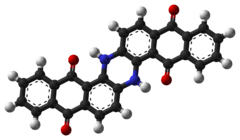Indanthrone blue
 | |
 | |
| Names | |
|---|---|
| Other names
C.I. vat blue 4, carbon paper blue, blue O, carbanthrene blue 2R, fenan blue RSN, graphtol blue RL, medium blue, monolite fast blue 3R, indanthrene, indanthrone, pigment blue 60, C.I. 69800 | |
| Identifiers | |
| 81-77-6 | |
| 3D model (Jmol) | Interactive image |
| 367131 | |
| ChemSpider | 6435 |
| ECHA InfoCard | 100.001.251 |
| E number | E130 (colours) |
| PubChem | 6690 |
| |
| |
| Properties | |
| C28H14N2O4 | |
| Molar mass | 442.43 g·mol−1 |
| Density | 1.6 g/ml |
| Insoluble | |
| Except where otherwise noted, data are given for materials in their standard state (at 25 °C [77 °F], 100 kPa). | |
| | |
| Infobox references | |
Indanthrone blue, also called indanthrene, is an organic dye made from 2-aminoanthraquinone treated with potassium hydroxide in the presence of a potassium salt. It is a pigment that can be used in the following mediums: acrylic, alkalyd, casein, encaustic, fresco, gouache, linseed oil, tempera, pastel, and watercolor painting. It is used to dye unmordanted cotton and as a pigment in quality paints and enamels. As a food dye, it has E number E130, but it is not approved for use in either the United States or the European Union.[1][2] Indanthrene Blue RS was patented in 1901 by Rene Bohn as the first anthraquinone vat dye, one of the dyes with very good fastness to light and washing.
Properties
It has the appearance of blue needles with metallic luster and melting point of 470–500 °C (878–932 °F). It has excellent light fastness, but may bleed in some organic solvents.